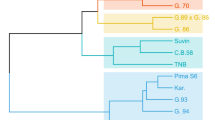Summary
Heterosis (over mid parent) and “useful” heterosis (over commercial variety H14) estimates were obtained from a line x tester analysis of crosses involving thirteen diverse female parents with two locally adapted varieties H14 (local standard) and J34. Marked heterosis was observed for seed cotton yield, boll number and halo length. The values of positive heterosis and “useful” heterosis for seed cotton yield ranged from 28.1 to 87.0% and 20.1 to 45.5%, respectively. The overall study of heterosis revealed that female parents PRS-72 (USSR), 5904F (USSR) and MCU-5 (Madras Cambodian Uganda Selection, Coimbatore) were among the top three females, showing considerable heterosis in crosses with H14 and J34 for seed cotton yield and fibre properties. The practical difficulties in exploiting the phenomenon of heterosis and possible experimental approaches in upland cotton are discussed.
Similar content being viewed by others
Literature
Doggett, H.; Eberhart, S.A.: Recurrent selection in Sorghum. Crop Sci. 8, 119–121 (1968)
Eberhart, S.A.; Harrison, M.N.; Ogada, F.: A comprehensive breeding system. Der Züchter 37, 169–174 (1967)
Falconer, D.S.: Introduction to quantitative genetics. New York: Ronald Press 1960
Hawkins, B.S.; Peacock, H.A.; Ballard, W.W.: Heterosis and combining ability in upland cotton — Effect on yield. Crop Sci. 5, 543–546 (1965)
Hooda, R.S.: Line × tester analysis of heterosis and combining ability in upland cotton, Gossypium hirsutum L. M.Sc. Thesis, P.A.U. (Unpublished 1969)
Jones, J.E.; Loden, H.D.: Heterosis and combining ability in upland cotton. Agron. J. 43, 514–516 (1951)
Katarki, B.H.: Varalaxmi Hybrid Cotton — A valuable import substitute. Cotton Development 2 (3), 3–11 (1972)
Lee, J.A.; Miller P.A.; Rawlings, J.O.: Interaction of combining ability effects with environments in diallel crosses of upland cotton (Gossypium hirsutum L.). Crop Sci. 7, 477–481 (1967)
Meredith, W.R., Jr.; Bridge, R.R.: Heterosis and gene action in cotton, Gossypium hirsutum L. Crop Sci. 12, 304–310 (1972)
Miller, P.A.; Lee, J.A.: Heterosis and combining ability in varietal top crosses of upland cotton, Gossypium hirsutum L. Crop Sci. 4, 646–649 (1964)
Patel, C.T.: Hybrid-4: a new hope towards self-sufficiency in cotton in India. Cotton Development 1, 1–5 (1971)
Pathak, R.S.: Genetics of cluster and certain quantitative characters in upland cotton, Gossypium hirsutum L. Ph.D. Thesis, P.A.U. (Unpublished) (1968)
Singh, B.B.; Murty, B.R.: Hybrid vigour in intervarietal crosses of upland cotton. Indian J. Genet. 31, 1–7 (1971)
Singh, R.B.; Gupta, M.P.; Tikku, P.L.; Tomar, R.S.; Dharampal; Bisley, D.S.: Line × tester analysis of heterosis and combining ability in upland cotton. Indian J. Heredity 1, 175–184 (1969)
Suwantaradon, K.; Eberhart, S.A.: Developing hybrids from two improved maize populations. Theoret. Appl. Genet. 44, 206–210 (1974)
Young, E.F., Jr.; Murray, J.C.: Heterosis and inbreeding depression in diploid and tetraploid cottons. Crop Sci. 6, 436–438 (1966)
Author information
Authors and Affiliations
Additional information
Communicated by H. Stubbe
Rights and permissions
About this article
Cite this article
Pathak, R.S., Kumar, P. A study of heterosis in upland cotton (Gossypium hirsutum L.). Theoret. Appl. Genetics 47, 45–49 (1976). https://doi.org/10.1007/BF00277404
Received:
Issue Date:
DOI: https://doi.org/10.1007/BF00277404




